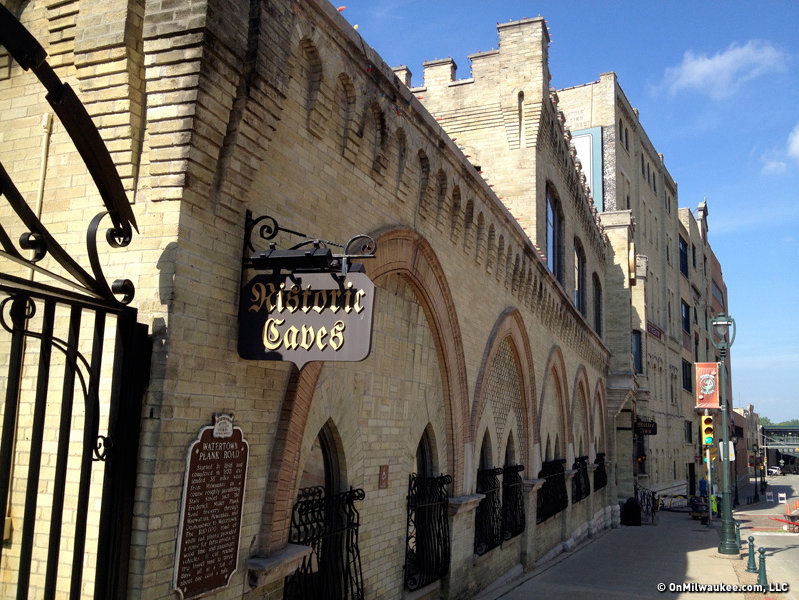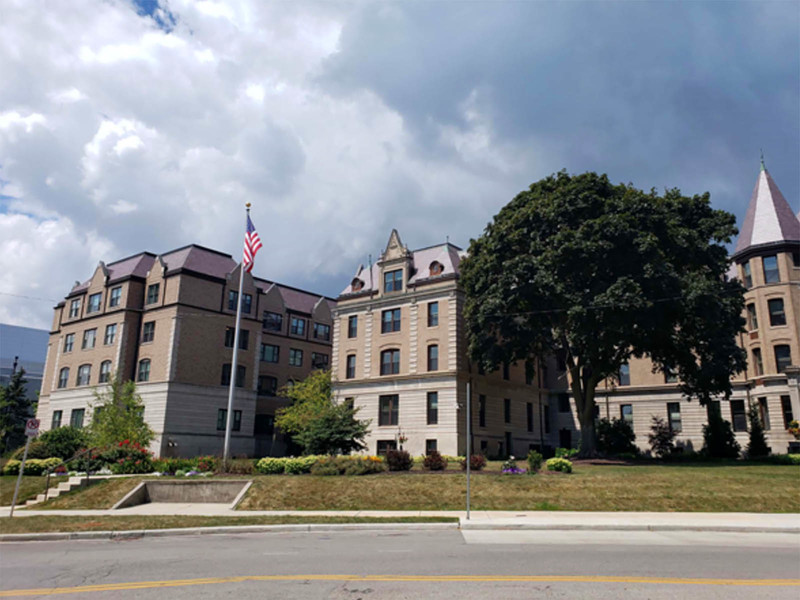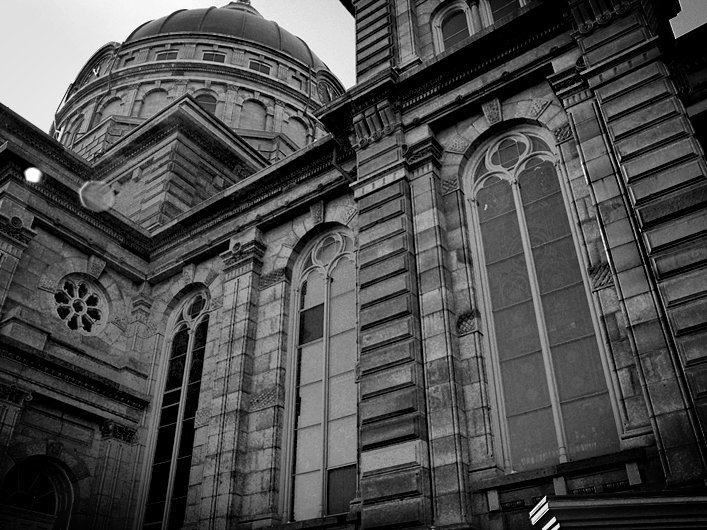Though Liberace was on hand to help celebrate the opening of the then-century-old Miller Caves as a museum, everyone seems to agree that the Sunday, June 16 appearance by John C. Reilly & Friends will mark the first concert in the barrel-vaulted subterranean venue.
The multi-talented Reilly – renowned as an actor, comedian, producer and screenwriter, but also as a folk musician – will perform alongside fellow band members Becky Stark and Tom Brosseau and with special guest Andru Bemis at 6 p.m. and 9:30 p.m. Because of the nature of the venue – small, dark and underground – only 100 tickets were available for each sold-out performance.
The caves, which are a beloved feature of the Miller Brewing Co. brewery tours, were excavated into the side of the bluff – 60 feet below the hilltop – that runs along the south side of State Street in 1850 by the Best Brothers, who owned the Plank Road Brewery on the site.
Frederick Miller started his own brewery in 1855 and bought the Plank Road Brewery from Charles and Lorenz Best – sons of Pabst founder Jacob Best – and the caves were part of the deal.
"This is where they kept beer cold," says Kindra Loferski, guest relations manager at Miller Coors, while leading me down a brick corridor opening into the cool, dimly lit caves. "Mechanical refrigeration was not invented, so they cut large blocks of ice from local lakes and rivers. Pewaukee Lake was the primary source for the ice. They would bring it in by horse and wagon, and they would line the walls of the caves and cover it with sawdust and hay. Then they’d bring all of the wooden barrels of beer in here, and that would keep them cold through the really hot summer months."
The temperature is pretty constant in the cave, which was apparently the largest in a system of caves that went about 600 feet deep into the bluff. All of the others have since been permanently sealed off, though you can still see entrances to at least three of them in the remaining cave.
According to a 1938 newspaper article there were five caves. The smallest was about 20 feet long and about 8 feet high and the largest – the extant cave – is about 80 feet long, 20 feet wide and 20 feet tall. Gettleman also had caves, which it stopped using at the turn of the 20th century. Because they didn’t have hills to dig into, Pabst, Blatz and Schlitz relied on underground cellars to keep their beer cool.
Loferski notes that beneath the grassy exterior, the hillside is still a hive of activity as Miller has facilities built into the bluff that remain in daily use.
The caves’ role as a beer storage site ended in 1906 and they fell into disuse until they were reopened in the 1950s as a museum.
"They closed them off and didn’t use them for anything," says Loferski. "They were reopened Frederick Miller’s grandson, Frederick C. Miller. He had a vision to be able to use this space for very high-end dinners and special events. He did a museum in here to initially open it up."
Since 2004, Miller has used the space for beer pairing dinners and other events. And, yes, some musicians have performed during those events, so you can decide if Reilly really gets the distinction as the first concert performer in the space, but his is the first event staged specifically as a concert.
"It’s been something that’s been in the rumblings of our office for years," says The Pabst’s Andrew Nelson. "Once Gary (Witt) saw this place, he really thought that these were the beginnings of Milwaukee, and he couldn’t think of a cooler place to do a show. It was kind of always in the works, but waiting for the right thing to come along."
Nelson says they’ve been talking to Reilly about doing a show for more than a year. Because of Reilly’s penchant for performing in unusual venues, The Pabst team was looking for a cool spot for a gig.
"We were looking at some other spaces, too, but I think it was never going to happen until we got this space," says Nelson. "From management to John C. Reilly himself, they are incredibly excited. I think we’ll be able to ask him on the day of, but from what we gather, he’s never played a place quite like this.
"We waited for the exact right artist and the exact right space."
Loferski says the excitement was immediate on the Miller side, too.
"It didn’t take a lot of arm-twisting (to convince Miller)," she says. "When The Pabst approached us about this, it took next to no convincing, and we were like ‘yeah, let’s give this a shot,’ because the uniqueness – the opportunity to show the community – and if they can’t actually attend, just via the media, to let them experience the caves in some small way."
And lest you think that a concert in a pretty small cave made entirely of brick and stone isn’t a very good idea from an acoustical standpoint, think again.
"It’s a folk band, so it’s not going to be that loud, but I think a lot of readers would be surprised to hear that there was a lot of major work done to the acoustics in here in 2008 (as) part of the million-dollar renovation," says Loferski. "We did very significant renovation to the caves, and because we were doing so many of those beer pairing dinners, we wanted to enhance the sound in here."
To that end, a number of sound-deadening acoustic panels were added to the cave’s interior. Despite the fact that they are in plain site, you might never find them even if you spend a lot of time looking. But their effect is notable, says Loferski, who says the panels have made a huge difference.
The caves are certainly an evocative place for an event of any kind. Guests enter through a gate and then a heavy door that looks to lead straight into the hillside, because, of course, it does. Inside, the air is a bit damp and the lighting is low.
Through the low-ceilinged tunnel at right you can see a great fountain that pays tribute to Flemish King Gambrinus, the unofficial patron saint of beer. Jog left and before you opens the more spacious, but still intimate main cave, with a stage on the far end.
It puts me in mind of the legendary Cavern Club where The Beatles got their start in Liverpool. I can imagine shows here.
"I would say there’s the possibility out there (for this to become a door-opening event)," says Nelson, "(but) it has to be the perfect fit. I think there’s a few things that would work down here. Something that has a story to it, and makes sense. It’s not going to be just some random show, or every week there’s going to be a show in here. This is our way of going out into the community and going into a really unique space and creating an experience unlike anywhere else in the world."
And the caves are unlike anything else. That 1938 newspaper article posited that the caves were among the last still in existence in the U.S. Three-quarters of a century later, that seems even more likely. And built just a few years after the City of Milwaukee was chartered, the caves are about as Milwaukee as you can get.
"You feel like you’re going back in time and seeing where the city began, and that’s something that you can’t fake," says Nelson. "It’s not some cool, new music venue. This is a place that has so much history behind it. That’s going to make the experience that much better."
Born in Brooklyn, N.Y., where he lived until he was 17, Bobby received his BA-Mass Communications from UWM in 1989 and has lived in Walker's Point, Bay View, Enderis Park, South Milwaukee and on the East Side.
He has published three non-fiction books in Italy – including one about an event in Milwaukee history, which was published in the U.S. in autumn 2010. Four more books, all about Milwaukee, have been published by The History Press.
With his most recent band, The Yell Leaders, Bobby released four LPs and had a songs featured in episodes of TV's "Party of Five" and "Dawson's Creek," and films in Japan, South America and the U.S. The Yell Leaders were named the best unsigned band in their region by VH-1 as part of its Rock Across America 1998 Tour. Most recently, the band contributed tracks to a UK vinyl/CD tribute to the Redskins and collaborated on a track with Italian novelist Enrico Remmert.
He's produced three installments of the "OMCD" series of local music compilations for OnMilwaukee.com and in 2007 produced a CD of Italian music and poetry.
In 2005, he was awarded the City of Asti's (Italy) Journalism Prize for his work focusing on that area. He has also won awards from the Milwaukee Press Club.
He has be heard on 88Nine Radio Milwaukee talking about his "Urban Spelunking" series of stories, in that station's most popular podcast.







